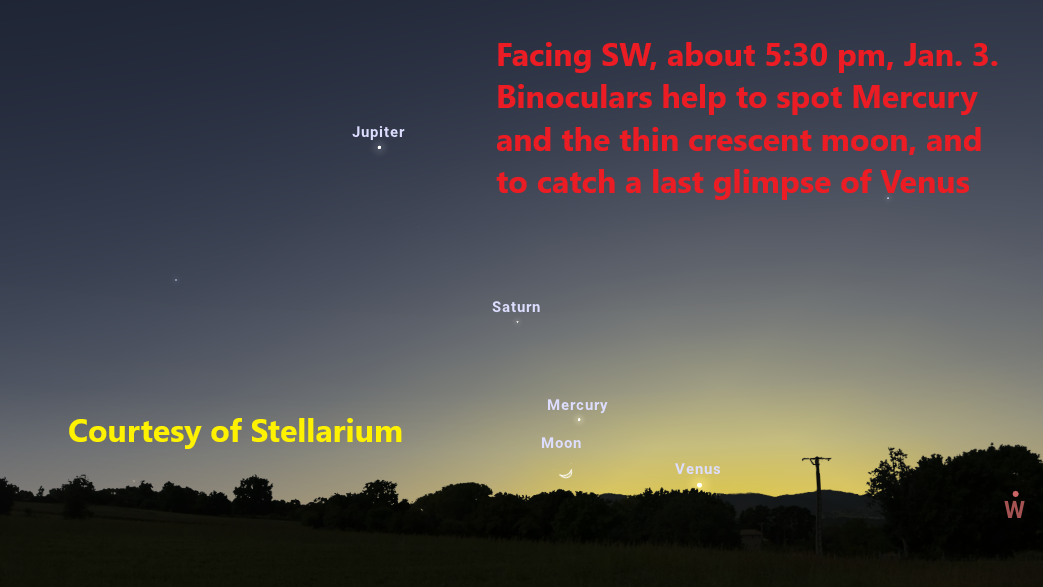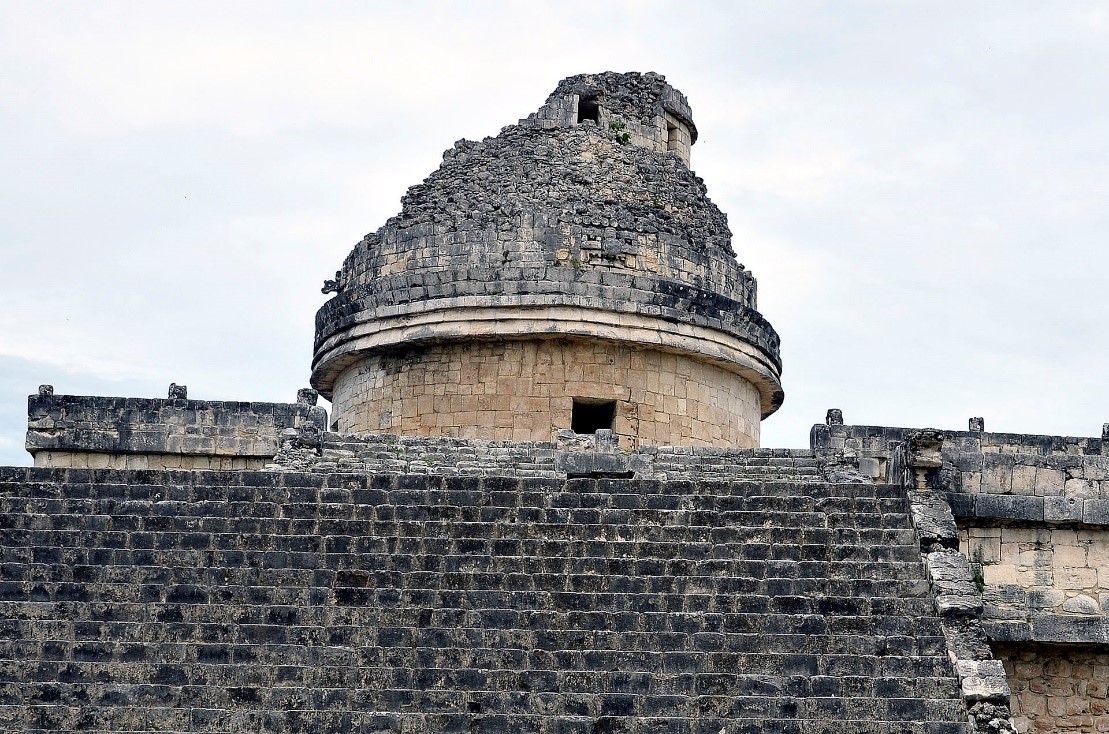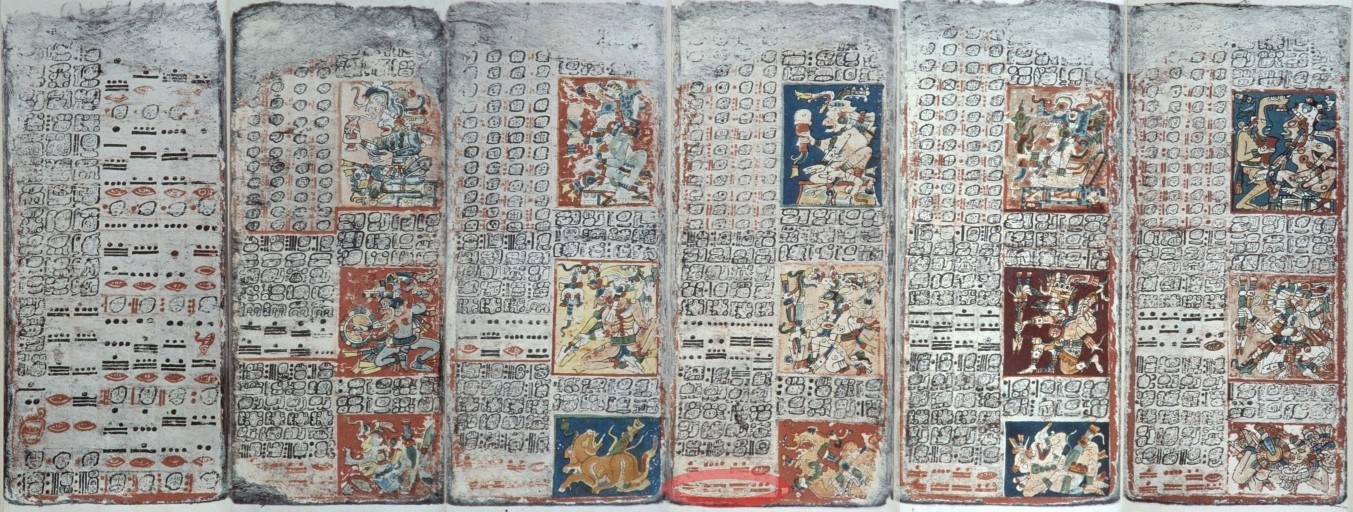CRACKING THE VENUS CODE-X
Other than family, I have had two long term hobbies in life- history and stargazing. Any time that I can combine the two of them, it is even better. Venus’ current transition from evening to morning sky offers this chance, as we will see here.
Sky watchers can scan the southwestern sky just after sunset at the beginning of January to get a last glimpse of Venus during its current apparition. It passed on the far side of the Sun as seen from Earth, and first appeared in the evening sky last April, or about 250 days ago. Perhaps the best night to get a last look will be on January 3, when a very thin crescent moon may help you to locate Venus, as shown below. Find a spot with an open view to the southwestern horizon, and while looking through the bright twilight about a half hour after sunset, look about one fist’s width to the right of the Moon. Binoculars will probably help you to spot Venus this night, and using them, you may be able to keep track of it for another night or two after the 3rd. If you do see it, if you have good binoculars, you should notice Venus’ delicately thin crescent phase. A few eagle-eyed people, including apparently Edgar Allan Poe, have discerned Venus’ crescent with their unaided eyes. After this point, Venus will be so much in between the Earth and Sun that it will appear to vanish from our skies for a period of about eight days. Just before mid-January, a close scan of the southeastern horizon a half hour before sunrise may get you a first glimpse of Venus , emerging into view in the dawn skies, where it will reside for about the next 236 days, or eight months.

The term inferior conjunction refers to the point on January 8 when Venus is most nearly between Earth and Sun, and its first appearance after it is called heliacal rising. The Maya civilization likened the disappearance of Venus from the evening sky and its heliacal rising in the morning sky about eight days later to the death and resurrection of Kukulcan, their Sky God. The Mayans of course did not have binoculars or telescopes, but they were keen stargazers and enjoyed clear, unpolluted, dark skies in the Yucatan desert that few of get to experience today. Based upon years of observation, they noted that Venus followed this schedule:
Day 0: Heliacal rising (first visibility) of Venus in the morning sky, just before sunrise
Day 236: Last visibility in the morning sky- varies slightly depending upon the time of year and the weather.
Day 236-325: Venus is invisible, on the far side of the Sun as seen from Earth (superior conjunction).
Days 326-576: Venus is visible in the evening sky, after sunsetDays 577-584: Venus is invisible between the Earth and Sun (inferior conjunction)
Days 577-584: Venus is invisible between the Earth and Sun (inferior conjunction)
The Maya even noticed that five of these cycles totaled 2,920 days, meaning that appearances of Venus essentially repeated themselves every eight years- use a calculator and divide 2,920 by 365 to see for yourself! What the Mayans apparently did not understand was the cause of this cycle. Venus and Earth have a permanent race around the Sun, with Venus having the inner and faster track, taking 224 days to orbit the Sun. Since the Earth is moving around the Sun as well (365 days for one orbit, of course), the two planets are in the same place relative to each other once every 584 days.
These dates above are more or less correct as seen with the unaided eye, but the use of modern binoculars greatly reduces the amount of time that Venus is invisible. If you use a guided telescope, filtered against the Sun’s glare, Venus is always visible except in the case of very rare transits in front or behind the Sun. Because of the tilt of its orbit relative to the Earth-Sun line, Venus almost always passes above or below the Sun as seen from Earth, even when in inferior conjunction. I was lucky enough to view both the 2004 and 2012 transits of Venus, but hardly anyone alive today will see the next one, in 2117.
The Maya are believed to have made many of their sky observations from El Caracol, in Chichen Itza, the center of their civilization. Built around 900 A.D., it offered great horizons in all directions, and various pathways and slits cut into the tower point to cardinal directions, equinoxes, solstices, and other celestial landmarks. The main stairway entering El Caracol is aligned almost precisely with the northern extreme of Venus within the eight year cycle.

The Mayans possessed a written language and created numerous books, or codicies, all beautifully handmade and drawn. Almost all of these unfortunately were destroyed by the invading Spanish hundreds of years later, so that only four are known to exist today. The famous Dresden Codex, in the hands of the Saxon State Library in that German city, is one of the most complete, in spite of suffering damage as a result of the bombing of the city during World War II. Ernst Wilhelm Forstemann, one of the librarians during the late Nineteenth Century, managed to decode the Maya hieroglyphics. Amazingly, page 48 of the Dresden Codex includes a series of numbers that totals 236, 90, 250, & 8- the code of Venus visibility!

This January offers stargazers everywhere a chance to duplicate the observations made by the Maya civilization so many centuries ago, and no equipment is necessary (binoculars can help)- just open horizons and the fortitude to survive the winter cold for a few minutes.
